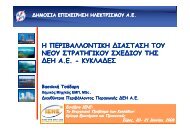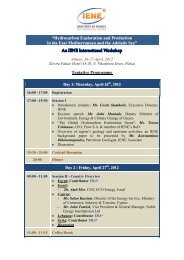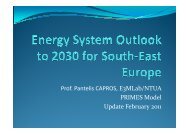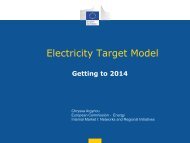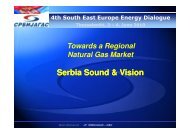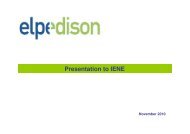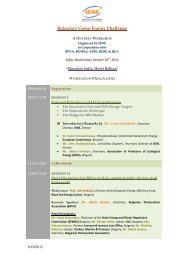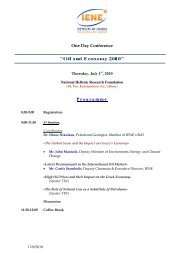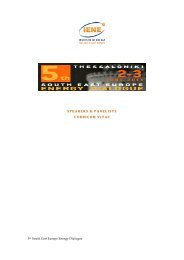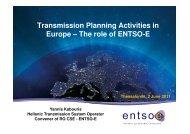Mr. Ilia Gjermani
Mr. Ilia Gjermani
Mr. Ilia Gjermani
- No tags were found...
Create successful ePaper yourself
Turn your PDF publications into a flip-book with our unique Google optimized e-Paper software.
“PETROLEUM EXPLORATION,<br />
DEVELOPMENT AND PRODUCTION<br />
OPPORTUNITIES IN ALBANIA”<br />
(COUNTRY OVERVIEW)<br />
IENE’S INTERNATIONAL WORKSHOP ON<br />
“Hydrocarbon<br />
Exploration and Production in the East Mediterranean and the Adriatic Sea”,<br />
Athens, GREECE<br />
26-27, 27, April , 2012.<br />
1
CONTENT<br />
I. REGIONAL SETTING OF ALBANIA<br />
II.<br />
III.<br />
IV.<br />
REGIONAL GEOLOGICAL SETTING<br />
OIL GEOLOGY AND HYDROCARBONS EVENTS<br />
EVALUATION OF EXPLORATION OPPORTUNITIES IN ALBANIA<br />
V. EVALUATION OF DEVELOPMENT AND PRODUCTION<br />
OPPORTUNITIES IN ALBANIA<br />
VI.<br />
VII.<br />
PRIVATISATION OF ALBEPTROL Sh.A.<br />
LEGAL AND INSTITUTIONAL FRAMEWORK.<br />
CONCLUSIONS<br />
2
I. REGIONAL SETTING<br />
Albania is located in the<br />
Southeast of Europe.<br />
Albania by land is bordered<br />
with Monte Negro in the<br />
North, Kosovo and “Former<br />
Republic of Macedonia” in<br />
northeast and east, and by<br />
Greece in the<br />
South and Southeast,<br />
ALBANIA<br />
whereas<br />
in the West it is bordered<br />
by the Adriatic and Ionian<br />
Seas.<br />
It is about 28.000 km 2<br />
3
II. REGIONAL GEOLOGICAL SETTING<br />
From the geological point of<br />
view,<br />
Albania is part of the<br />
Mediterranean Alpine<br />
Folded Belt and fits in the<br />
Dinaric-Hellenic range,<br />
between the Dinarides in the<br />
North and Hellenides in the<br />
South.<br />
The geological structure<br />
constituting Albania is<br />
called the Albanides, a<br />
term widely used at home<br />
and abroad.<br />
ALBANIDES<br />
S<br />
The Albanides are divided into<br />
- INTERNAL ALBANIDES.<br />
and<br />
- EXTERNAL ALBANIDES.<br />
4
II. REGIONAL<br />
GEOLOGICAL SETTING<br />
(2)<br />
The Internal Albanides are characterized<br />
by developed magmatism and by intensive<br />
tectonics which has led to the over thrust<br />
and tectonic napes.<br />
The Internal Albanides consist of thee<br />
tectonic zones, which from east to west<br />
are:<br />
- the Korabi zone,<br />
- The Mirdita zone<br />
(the main ophiolite bearing zone),<br />
- and Gashi zone.<br />
The two post orogenic sedimentary (intermountainous)<br />
basins respectively: Burreli<br />
Basin in the north and Korca Basin in the<br />
southeastern part of Albania, overlie<br />
transgressively the Mirdita zone and partially<br />
the Krasta-Cukali zone.<br />
Fig.1<br />
5<br />
The main structural-tectonic units in Albanides
II. REGIONAL GEOLOGICAL<br />
SETTING (3)<br />
The External Albanides on the contrary are<br />
characterized by the lack of magmatism and by<br />
more regular structural models but which are<br />
associated with considerable thrusts.<br />
From east to west, the External Albanides is<br />
devided into the following zones:<br />
-The Albanian Alps zone,<br />
-The Krasta-Cukali zone,<br />
-the Kruja platformic zone<br />
-the Ionian trough<br />
and<br />
- the Sazani platformic zone<br />
Northwards the overlying Peri-Adriatic<br />
Depression (PAD) masks the Ionian and,<br />
partly Kruja tectonic zones.<br />
Westwards offshore, the Peri Adriatic Depression<br />
is unified with the South Adriatic Basin, which<br />
overlay the Preapulian (Sazani zone) and<br />
Apulia Platform.<br />
Fig.1<br />
The<br />
6main<br />
structural-tectonic units in Albanides
II. REGIONAL GEOLOGICAL SETTING (4)<br />
The relative<br />
movements of the<br />
Adriatic sub plate and<br />
the Euro Asiatic plate<br />
from Mesozoic to<br />
Tertiary mainly controlled<br />
tectonic evolution of the<br />
Albanides where some<br />
tectogenic phases have<br />
been recorded in the<br />
Albanides during the<br />
period of time.<br />
Geological – geophysical sections on the<br />
northern and central part of Albanides.<br />
7
III. Oil Geology and hydrocarbons events<br />
8<br />
The location of main oil and gas field in Albania
III. Oil Geology and hydrocarbons events<br />
Albania was established as a Hydrocarbon<br />
bearing province as early as Roman times,<br />
when heavy oil and asphalts of Selenica<br />
mine were used for lamps.<br />
In 1918 the first oil discovery was<br />
made in Oligocene flysch in Drashovica.<br />
In 1927, 1928 respectively Kucova and<br />
Patosi oil fields related to Messinian clastic<br />
reservoirs were discovered.<br />
Marinza as the biggest oil field in Albania<br />
related to Messinian-Tortonian clastics<br />
reservoirs was discovered in 1957.<br />
9<br />
Oil and Gas Fields in Albania
III. Oil Geology and hydrocarbons events<br />
Visoka, as the first oil field related to<br />
carbonate reservoirs, discovered in<br />
1963, was followed by other<br />
discoveries such as: Gorishti (1965),<br />
Ballshi (1966), Finiq-Krane (1974),<br />
Cakran-Mollaj (1977), Amonica<br />
(1980) and Delvina (1987).<br />
With the first Gas discovery<br />
(1963) in the Tortonian<br />
sandstone layers of Divjaka, other<br />
gas fields respectively: Frakulla<br />
(1972), Ballaj 1983, Povelca and<br />
Panaja gas fields in 1987 and<br />
Durresi (1988) were discovered.<br />
10<br />
Oil and Gas Fields in Albania
III. Oil Geology and hydrocarbons events<br />
11<br />
A summary of the Exploration History in Albania
III. Oil Geology and hydrocarbons events<br />
12<br />
First Offshore Bidding Round<br />
In the offshore bidding round, the Albanian<br />
offshore was divided in 5 blocks with a total<br />
surface area of 11763 km 2 which were<br />
offered to the international oil companies.<br />
At the end of the round, 5 Petroleum Sharing<br />
Agreements were signed for 5 blocks<br />
offered, respectively.<br />
Block Rodoni-1 to DEMINEX Co.<br />
(German) and OMW Co. (Austrian)<br />
Block Adriatiku-2<br />
Block Adriatiku-3<br />
(American)<br />
Block Adrialtiku-4<br />
(American)<br />
Block Joni-5<br />
(Australiane)<br />
to AGIP Co. (Italian)<br />
to Occidental Co.<br />
to CHEVRON Co.<br />
to HAMILTON OIL Co.<br />
The Albanian offshore was completely<br />
unexplored with a total absence of data.<br />
Totol investment 147 Milion USD<br />
The A4-1x well drilled (1993 by<br />
AGIP and Chevron in offshore<br />
Albania (Adriatiku-4) proved to<br />
be as a light oil (condensate) and<br />
gas bearing in Messinian clastic<br />
reservoir.
III. Oil Geology and hydrocarbons events<br />
First round onshore (1992)<br />
In 1992, the First Exploration Round for oil and<br />
gas onshore was opened for blocks A,B,C,D,E, and<br />
F, of a total surface area of 4200 km 2 . This round<br />
was declared closed in 1994 with the signing of<br />
three exploration contracts with production sharing<br />
for four blocks as follow:<br />
- Blocks B and F to SHELL (Dutch)<br />
- Block C to Ina - Naftaplin (Croatian)<br />
- Block E to COPAREX International<br />
(French)<br />
The studies made in these blocks have identified a<br />
series of formations of interest for oil and gas<br />
exploration, of which only one well has been<br />
drilled by Ina-Naftaplin without the target being<br />
reached.<br />
Totol investment 45 milion USD<br />
13<br />
F<br />
A<br />
B<br />
C<br />
INA<br />
D<br />
E
III. Oil Geology and hydrocarbons events<br />
Second licensed round in Albania ( onshore<br />
blocks , November 1995)<br />
In following up the policy for the attraction of<br />
foreign investments in gas and oil exploration<br />
sector in Albania, in 1995, the Government of<br />
the Republic of Albania, through the National<br />
Petroleum Agency opened the Second<br />
Licencing Round for gas and oil exploration<br />
and production onshore, for a surface area of<br />
22 400 km 2 .<br />
In conclusion, six agreements were signed in<br />
1998, four of which are from the Second<br />
Round blocks and two blocks, A and D, from<br />
the First Round.<br />
Blocks A and 2, 3 to OXY (USA)<br />
Blocks D to Coparex (France)<br />
Blocks 5 and 4 to OMW and Hellenic<br />
Petroleum<br />
Block 1<br />
to Hellenic Petroleum<br />
Totol investment during this round were about<br />
70 Million USD<br />
The first oil discovery onshore<br />
Albania was made by<br />
CCCIDENTAL of Albania in the<br />
year 2001, after the first drilling<br />
(Shpiragu-1well) into the Sqepuri<br />
structure situated in Block 2 Area.<br />
14
IV. EVALUATION OF EXPLORATION OPPORTUNITIES IN<br />
ALBANIA (1)<br />
Based on the geological studies, old seismic lines performed by Albpetrol and these<br />
performed in the recent years by the foreign companies it appears that, Albania, in spite<br />
of the existing oil and gas fields, still has a very good potential and is very promising<br />
area for further exploration in both onshore and offshore.<br />
ONSHORE AREAS<br />
Thrusting westwards in the Albanides and especially in the External Albanides are<br />
associated with the masking of the separate anticline structures or anticline chains,<br />
which have potential for new oil and gas discoveries.<br />
In the cases when thrusting westward is associated with the back thrust tectonic faults,<br />
synclines of triangular type are formed which are not easily identified but generally hide<br />
potential structures for oil and gas discoveries.<br />
From this point of view, still there is enough room for further exploration for identifying<br />
the new possible sub thrust structures in onshore areas.<br />
Gas Potential discoveries could be found under the existing oil discoveries in the deeper<br />
levels, but the seismic information it is not enough, to draw the prospects. New<br />
reprocessing and acquisition of new seismic data are necessary for this target.<br />
15
IV. EVALUATION OF OF EXPLORATION OPPORTUNITIES IN<br />
ALBANIA (2)<br />
OFFSHORE AREAS<br />
Oil Potential in the offshore area is related<br />
to the Possible Ionian carbonate structures<br />
and morphological highs of Apulia platform.<br />
In the appropriate conditions and places in<br />
the offshore there are possibilities for<br />
finding of the new and potential oil<br />
accumulations both in the clastic section<br />
(charged by the underlying platform<br />
carbonate) as it was the case in A4-1x well,<br />
and/or in the platform carbonate<br />
reservoirs.<br />
Gas Potential is related to the Miocene–<br />
Pliocene folded structures, as identified in<br />
the offshore to be valid based on old<br />
seismic (1991) and confirmed by the new<br />
seismic recently acquired.<br />
Taking into consideration the fact that, the<br />
dimensions of the prognoses structures in<br />
offshore are considerably larger than their<br />
analog structures in the existing gas fields<br />
in onshore, big reserves of biogenic and /or<br />
termoogenic area expected to be found in<br />
the area,<br />
Offshore seismic section on the Block 4<br />
16
IV. EVALUATION OF OF EXPLORATION<br />
OPPORTUNITIES IN ALBANIA (3)<br />
Geological survey has been in the leading role of the all oil and gas<br />
exploratory methods in Albania thrust belt over the past sixty years. So,<br />
based chiefly on surface geology data is realized the discovery of the Gorisht field,<br />
etc.<br />
Meanwhile, 2D seismic survey has been the second progress resulted<br />
in some other discoveries as Finiq-Krane, Cakran and Amonica fields.<br />
Whereas the 2D & 3D seismic survey has faced serious restrictions<br />
owing to the existence of intensive flysch folding frequently complicated<br />
by different faults, steep flanks and closers, as well as small wideness of the oil<br />
prospects, which sometime are masked by eroded and thrusted anticline structures.<br />
Anyhow, the seismic survey method, frequently have faced serious restrictions<br />
and consequently, since the project of the wildcat of the last field discovered there is<br />
huge time gap of dry exploration in Albania.<br />
On the other hand considering enormous compelled geological<br />
geophysical data and syntheses carried out so far have revealed a great<br />
similarity between the Albanides and Hellenides geological setting<br />
17
IV. EVALUATION OF OF EXPLORATION OPPORTUNITIES<br />
IN ALBANIA (4)<br />
Most likely the negative results have come from:<br />
• The presence of the carbonate sheets with high impedance to surface<br />
represents a major obstacle to the propagation of seismic energy.<br />
• The inadequate method adopted for resolving the complex velocity field<br />
in poor signal-noise conditions.<br />
• Carrying out insufficient surface geological mapping or former maps<br />
revisions.<br />
• Improper orientation of seismic lines for recording carbonates prospects’<br />
structural features.<br />
18
IV. EVALUATION OF OF EXPLORATION<br />
OPPORTUNITIES IN ALBANIA (5)<br />
Actually are under operation for the<br />
exploration oil and gas the following<br />
Petroleum Agreements:<br />
*Durresi block offshore, with the company<br />
SANLEONE<br />
*Joni 5 block offshore, with the company<br />
Medoil, which was bought by Cairn Energy<br />
company and the Agreement for this block<br />
is covered by the branch Capricorn Albania<br />
Ltd<br />
*A-B blocks onshore and the Agreement on<br />
blocks D-E onshore, with company<br />
Petromanas Albania<br />
*Blocks 2-3 onshore, with company<br />
Petromanas Albania<br />
*Block F with Bankers-Petroleum.<br />
*Block 4-5 and Dumrea, with company Sky<br />
Petroleum<br />
Until now in this activity is invested about 60<br />
milion USD<br />
19
Investment<br />
in Million USD<br />
NR. Company Block<br />
Effective<br />
Data<br />
Up to 2010 2011<br />
Total up to<br />
31.12.2011<br />
1<br />
San Leone<br />
Durresi 27.08.2004<br />
11,618.00 7,269.00 18,887.00<br />
2<br />
Joni 5 24.08.2007<br />
Capricorn 9,441.00 188.00 9,629.00<br />
3<br />
A+B<br />
…12.2007<br />
4,758.00 887.41 5,645.41<br />
4 Petromanas<br />
D+E …12.2007<br />
5 2+3 …07.2009<br />
9,809.00 1,171.30 10,980.30<br />
6,088.00 5,005.76 11,093.76<br />
6<br />
Bankers Petroleum F 17.12.2010 1,454.00 1,454.00<br />
Total 41,714.00 15,975.47 57,689.47<br />
Investment by current Exploration in Albania Bllock by the companies<br />
20
V. EVALUATION OF DEVELOPMENT AND PRODUCTION<br />
OPPORTUNITIES IN ALBANIA (1)<br />
Concerning oil and gas development and<br />
production from the existing oilfields are in<br />
operation through the Petroleum Agreement, with<br />
Albpetrol, actually state company, the following<br />
companies for the respectively field :<br />
•Bankers-Petroleum ALBANIA. On the Patos-<br />
Marinza oilfield.<br />
•Stream Oil & Gas” Ltd. On limestone oilfields<br />
Ballsh-Hekal, Cakran-Mollaj, Gorisht-Kocul and<br />
Delvinë .<br />
•Sherwood International Petroleum Inc. On the<br />
oilfield of Kucove<br />
•IEC Visoka Inc. On the oilfield of Visoke .<br />
In this activity until now are invested about 840<br />
milion USD<br />
21
V. EVALUATION OF DEVELOPMENT AND PRODUCTION<br />
OPPORTUNITIES IN ALBANIA (2)<br />
1000000<br />
900000<br />
800000<br />
Production of crude oil in years<br />
In tons<br />
M. Hidrokarbure<br />
Albpetrol<br />
700000<br />
600000<br />
500000<br />
400000<br />
300000<br />
200000<br />
100000<br />
0<br />
1997 1998 1999 2000 2001 2002 2003 2004 2005 2006 2007 2008 2009 2010 2011<br />
M. Hidrokarbure 0 0 0 0 0 0 40000 29000 98924 202500 282042 361744 396903 609683 832606<br />
Albpetrol 359666 364827 323009 314298 329359 350038 359255 370740 349116 316190 281147 215557 179723 132095 58923<br />
22
V. EVALUATION OF DEVELOPMENT AND PRODUCTION<br />
OPPORTUNITIES IN ALBANIA (Bankers Petroleum )<br />
About<br />
Strategy<br />
Canadian, Public, Calgary-based E&P company with an<br />
operational focus in Albania<br />
Large scale growth of recoverable heavy oil reserves through<br />
proven techniques and expertise<br />
Maximize the value of Bankers assets by funding growth through<br />
current cash position, cash flow and existing credit facilities<br />
Production<br />
Q1 - 2012 - Average Production 14,120 bopd<br />
Targeting 30% Annual Production Growth in 2012<br />
23
20000<br />
Cumulative production from horizontal program is ~ 4.5 million bbls<br />
Production (bbls/d)<br />
15000<br />
10000<br />
5000<br />
97 HZ<br />
Hz Wells: wells 114<br />
Vt Wells: 161 160 VT<br />
wells<br />
0<br />
24<br />
Vertical Wells<br />
Horizontal Wells (bbls/d)
PATOS-MARINZA<br />
Capital<br />
(Million US$)<br />
Horizontal and Vertical Wells 131<br />
Well Reactivations 18<br />
Base Program 45<br />
Facility Infrastructure<br />
BEYOND 2012<br />
Continuation of drilling, reactivations, water control<br />
and infrastructure<br />
Capital for thermal pilot programs only – commercial<br />
expansions to be determined after obtaining results<br />
of the thermal pilots<br />
Pipeline/Sales Infrastructure<br />
Water Control/Disposal<br />
Environmental Stewardship<br />
Geology and Geophysics<br />
Thermal Pilot Project 4<br />
BLOCK F<br />
Seismic and Drilling<br />
KUÇOVA<br />
Wells/Waterflood<br />
5<br />
12<br />
Total 215<br />
25<br />
2012 Drilling program will focus 75% on Production Growth, 25% on Reserves Growth<br />
* 2013 – 2015 capital programs to average $200 - $300 million/year subject to<br />
oil price
V. EVALUATION OF DEVELOPMENT AND PRODUCTION<br />
OPPORTUNITIES IN ALBANIA ( Stream Oil & Gas Ltd)<br />
Stream Oil & Gas Ltd. is a Canadian-based emerging oil and gas production,<br />
development and exploration company focused on the re-activation and redevelopment<br />
of three oilfields and a gas/condensate field in Albania. The<br />
Company’s strategy is to use proven technology, incremental and enhanced oil<br />
recovery techniques to significantly increase production and reserves.<br />
Stream oil and gas has increased its current oil and gas production capacity to<br />
approximately 2,730 gross boed (approximately 2,100 net boed) despite surface<br />
facility constraints. Gross production has ranged between 2,100 and 2,700 boed as<br />
facility upgrades are implemented, which represents a net production capacity<br />
growth of over 300% since year end 2010. Production is currently constrained due<br />
to surface facility water handling capacity which is restricting full utilization of<br />
installed artificial lift equipment, The Company is undertaking surface facility<br />
improvements to resolve this issue. Additional sustained natural gas liquids<br />
production is expected after the installation of the injection compressor in Delvina<br />
in the second half of 2012.<br />
Stream has focused its field activities on completing a variety of pump installations<br />
and workovers of existing wells, while concurrently progressing with programs to<br />
26<br />
access the Company’s large resource opportunity.
During fiscal 2011<br />
At the Cakran-Mollaj oilfield, gross production peaked at 1,450 bbls/d<br />
(approximately 1,240 net bbls/d)<br />
At the Gorisht-Kocul oilfield, current gross production averages approximately 780<br />
bbls/d (approximately 380 net bbls/d).<br />
At the Ballsh-Hekal oilfield The current field production of approximately 140 gross<br />
bbls/d (approximately 110 net bbls/d)<br />
Stream’s 2012 oilfield work plan includes the following:<br />
Execute approximately 100 well interventions and installation of modern pump<br />
systems;<br />
Optimize production operations to realize full benefit of the pump installations;<br />
Rehabilitate, debottleneck and modify the existing gathering and treatment<br />
facilities;<br />
Undertake geoscience programs to firm up incremental opportunities from infill<br />
drilling and EOR;<br />
Implement development planning activities to confirm CO2 flooding as an<br />
appropriate mechanism for EOR;<br />
Complete geoscience studies to confirm applicability of thermal recovery<br />
mechanisms (Gorisht-Kocul); and<br />
Continue the pilot water flood scheme while preparing to deploy the commercial<br />
waterflood program.<br />
Delvina Block exploration program continues 27 to advance in support of mid-2013 field<br />
activities and the subsequent plan of development submission to Albanian government.
VI. PRIVATISATION OF ALBEPTROL S.A.<br />
Privatization in exploration and production sector has been foreseen to be through<br />
the granting of right of use of existing oil and gas fields on the basis of Petroleum<br />
Agreements. So most of the oil and gas fields are given for development<br />
in this form.<br />
Currently according to the Government policies it is being carried<br />
out full privatization process of public company ALBPETROL Sh.A. for 100%, for<br />
which it is approved the legal framework and relevant legislation.<br />
According to the Law Nr.10490, dated 15.12.2011 “For determining the shape and<br />
the structure of privatization formula of the the company" Albpetrol “, it is foreseen<br />
to go in privatization :<br />
the technical assets such as two mechanical factory and some others services<br />
assets.<br />
Tree oil fields (Amonica, Drashovica and Pekisht Murizi) throw the Petroleum<br />
Agreements<br />
All gas fields which are at the final (depleted) phase.<br />
The right for Petroleum Agreement's in 7 exploration Block (Velca, Panaja, Blloku<br />
C,1, 6,7,8.)<br />
The right to manage all existing petroleum Agreements for EVALUATION OF OF<br />
28<br />
EXPLORATION in existion oil fields.
VII. LEGAL AND INSTITUTIONAL FRAMEWORK.<br />
The development and regulation of the hydrocarbon energy sector ia based on<br />
three main laws:<br />
Law no.7746, dated 28.07.1993“The Petroleum Law (Exploration and Production)”,<br />
as amended, which is harmonized with the Directive 94/22/EC of the European<br />
Parliament and of the Council of 30 May 1994 on the conditions for granting and<br />
using authorizations for the prospection, exploration and production of<br />
hydrocarbons,<br />
Law no.8450, dated 24.02.1999 “On refining, transportation and trading<br />
of oil, gas and their by-products” ,as amended. The provision of this law does<br />
not refer to a specific directive but is based on the legislation in force in some<br />
countries of EU (e.g. Greece) and in some directives.<br />
Law No. 9946, dated 30.06.2008 ”On the natural gas sector”, which is fully<br />
in compliance with: Directive 2003/55/EC of the European Parliament and of<br />
the Council of 26 June 2003 concerning common rules for the internal market in<br />
natural gas.<br />
29
VII. LEGAL AND INSTITUTIONAL FRAMEWORK.<br />
Concerning the activities in oil and gas sector, there are a number, beside<br />
these three main law, of specific legal acts and secondary legislation that<br />
regulate specific aspects of activities related to ensuring:<br />
• a international standard on exploration for oil and gas<br />
•a more efficient exploitation of the oil and gas fields,<br />
• production and trade of biofuels,<br />
• fiscal policies,<br />
•technical norms and standards for facilities and installations in the petroleum<br />
sector,<br />
•regulating the relations for the construction and operation of relevant<br />
infrastructure,<br />
•environmental issues etc..<br />
30
VII. LEGAL AND INSTITUTIONAL FRAMEWORK.<br />
- Law<br />
no.7746, dated 28.07.1993<br />
“On<br />
petroleum (Exploration<br />
and<br />
Production)”, as amended, created space and a bigger security for foreign<br />
investors in the exploration and production activities of hydrocarbons.<br />
The law recognizes the sovereignty of the Albanian state over hydrocarbons<br />
reserves, which remain property of the Albanian state.<br />
Contractors are granted exclusive rights for a period not more than 25 years to<br />
develop and exploit the petroleum reserves in the area of contract in<br />
accordance with the terms of a development plan approved by the Ministry<br />
responsible for energy, as well as to renew this right for another period as<br />
the agreement provides for.<br />
According to Petroleum law (Exploration and Production) the exploration and<br />
production can be conducted based on a Petroleum Agreement which has to<br />
be approved by the Council of Ministers.<br />
The Petroleum law contains other important provisions especially as to the<br />
protection of the environment and social rights of the communities in the<br />
area where an exploration and production activity is authorized.<br />
This law provides also for a stability clause which guarantees the contractors<br />
that any new law should not impact the economics terms of agreement.<br />
31
VII. LEGAL AND INSTITUTIONAL FRAMEWORK.<br />
- In 1994, the Albanian Parliament approved Law no.7811<br />
7811, dated<br />
12.4.19941994 “On<br />
the fiscal<br />
system of<br />
hydrocarbons<br />
sector”<br />
as<br />
amended.<br />
This law, which is a specific law applied only to the contractors<br />
operating in the petroleum exploration and production activities,<br />
created a greater security for private investors because, based on<br />
this law, all contractors were exempted from tax and other fiscal<br />
duties imposed by the Albanian state, and they would be subject<br />
only to the profit tax.<br />
- Mineral rent tax (Roylty tax), is a tax provided in Law No 9975,<br />
dated 28.7.20082008 “On national tax” ,as<br />
amended.<br />
In the event of selling mineral wealth for end consumption in the<br />
domestic market, mineral rent tax is paid to tax authorities (10%),<br />
by the subject owning the petroleum agreement.<br />
32
CONCLUSIONS:<br />
• Faced problems and negative exploration results in Albania thrust belts and elsewhere<br />
worldwide do not imply poor hydrocarbon perspective.<br />
•On the contrary, many oil and gas condensate prospects exist, but they need more accurate<br />
acquisition, processing, reprocessing, integration and interpretation of the all exploratory<br />
methods data.<br />
• Surely, geological survey must be in the leading role of the oil exploratory works in the thrust<br />
belt regions.<br />
• Seismic and all the other geophysical and geochemical exploratory methods must increase<br />
their solution capability carrying out methodical tests before shooting the all works volume.<br />
•Wherever placing of flysch folds is far of thrusting anticlinal belts and tectonic setting is<br />
relatively gentel, seismic sections present clearly reflection horizons. In such cases a small<br />
amplitude of thrust and a gentle folding asymmetry express the possibility that surface flysch<br />
fold reflect respective carbonate structures in depth (Gorisht, Cakran).<br />
• In this region, the presence of the sub-thrust structures with considerable amplitude<br />
increase the possibility for new discoveries , that means the region corporation is necessary .<br />
•The cooperation with international oil companies is very importante for Albania for more<br />
efficient exploration and exploitation of the oil and gas fields<br />
33
THANK YOU<br />
FOR YOUR ATTENTION<br />
For any further information you are welcome to visit<br />
www.mete.gov.al<br />
or contact me personally at<br />
<strong>Ilia</strong>.gjermani@mete.gov.al,<br />
iliagjermani@hotmail.com<br />
34



